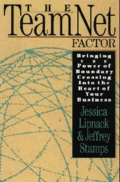June Holley, whose insights and methods for establishing and growing networks are in a class of their own, points today to Phanish Puranam's post on the INSEAD blog, "What Bossless Firms Can Teach Us."
Puranam's round-up of companies that have eschewed traditional hierarchy and bureaucracy for more intelligent self-management points to some popular and successful examples: Valve, the Seattle software company where employees vote with their seats for projects they want to work on (no votes, no project); the California tomato processor, Morning Star, that, as Puranam writes "bases its organisation on a sort of mission statement that is negotiated peer-to-peer rather than imposed by a boss, laying out each employee’s tasks and organisational affiliations;" and, the grandparent of them all, W.L. Gore and Associates, which I mentioned here.

We (Jeff Stamps and I) stumbled upon W.L. Gore when we were doing research for The TeamNet Factor, our 1993 book. Given all the hoopla about self-governance and jettisoning old authoritarian structures, I'm offering this excerpt which details how Gore has done it all these years. It's simple, sensible, and worth a try, C-Suiters. Good sense can prevail when the agreements, policies, and governance are in place throughout an organization, top-to-bottom. Gore's approach reflects both good organizational design, mutual respect, and a mature approach to how people come to work.
Take a look and see if this makes sense to you, noting Bill Gore's realistic caveats, typically overlooked in the idealistic vision of "leaderless" organizations espoused by people who haven't carefully considered what it takes to make people-working-together work.
From The TeamNet Factor, Chapter 4:
Meet the Lattice: The Free Form Organization That Makes Gore-Tex
Gore-Tex is" a miracle weave in the fabric of the world’s outdoor life." It evaporates sweat while protecting its wearer from the drench of rain. Gore-Tex is a visible, distinctive partner with producers of ski gloves, tents, and clothing of all descriptions. Like Dolby sound, Gore-Tex is known for the special contribution it makes to a wide range of products.
If ever there were a company whose product mirrored its culture, it is W L. Gore & Associates. This lattice textile is made by a lattice organization, a company designed for horizontal interactions where employees are known as “associates.”
In 1982, Inc. magazine runs a cover story on the Newark, Delaware, company best known for its popular product Gore-Tex. Headlined “The Un-manager: Without Ranks and Titles,” the story describes Bill Gore’s “not your average” almost-billion- dollar company. By 1991, the company is among the “400 largest private U.S. Companies.”2
The name “W. L. Gore & Associates” captures the essence of this remarkable enterprise. The design of the company is that of a network. Its core glue is the philosophy of its husband-and-wife founders, Wilbert (“Bill”), who died in 1986, and Genevieve, who remains involved in the company. Business Week features their son Robert in 1990 in an article titled “No Bosses. And Even Leaders Can’t Give Orders.”
The 1982 Inc. story so excites us that we call its author, Lucien Rhodes, who in turn forwards us a poorly typed document with a few handwritten notes on it that Bill Gore has sent him. “The Lattice Organization—A Philosophy of Enterprise” describes the Gore “bureaucracy”:
People group around projects undertaken on the basis of commitment.
The firm’s 5,600 associates (not employees)—now in 46 plants in six countries— have sponsors (not bosses), who serve as their mentors and advocates.
Gore’s projects are boundary crossing teams. “The mathematician, engineer, accountant, machinist, chemist and so on provide a combination of capabilities of a much broader scope than the mere sum of their number. This synergism . . . impels us to join together for mutual benefit.”
STUMP SPEECH TO THE TRIBES
Bill Gore’s paper, written in 1976, was the basis for many talks that he gave over the years to the company’s associates.4 (Which brings us back to the name: everyone who works at W. L. Gore & Associates is an associate.)
It’s not your typical corporate speech. With his ponderous, sometimes mystical tone, Gore sounds more like a 19th-century transcendentalist than the late-2Oth- century entrepreneur that he is. He begins with the “Nature of Man,” the starting point, usually unstated, of every corporate culture. One part of our heritage, he says, comes from hunters and predators with the urge to attack, destroy, loot, vanquish, and overcome competitors. Fortunately, humans evolved new social capabilities that carried the species far beyond this endowment. ‘A further great evolutionary invention is the cooperation of groups made possible by friendship and love.... The tribal group ... combines aggressive capability welded together by emotional interactions.” To Gore, the essence of human nature is co-opetition.
Besides being capable of friendship and love, he says, people are also dreamers. He asks what would happen if people doubled their brain capacity. “If the norm in our society is the utilization of say 10% of our inherent human capabilities, what would be the result if we were able to restructure . . . this to double to 20%?”
People participate in groups because together they can accomplish more than alone, he says. Gore believes accomplishment peaks with about 150 people in the same group. After that, results decline, and it’s time to form another group, a principle that the company puts into practice. Gore breaks plants apart when they exceed 150 to 200 people. This is, roughly, a tribal size, the upper-limit size of groups that people lived in after the invention of language but before the development of agriculture and cities.
When groups pass out of the realm in which everyone knows everyone else, Gore believes “we" quickly translates into “they.” This tiny language signal announces the beginning of turf wars, the identification of enemies, and win-lose maneuvers that eventually bring down even great companies.
THE LATTICE BEHIND THE FACADE
There’s another downside to groups of more than 150 to 200, Gore says. “Beyond some such level, it becomes necessary to impose rules, regulations, procedures and the like that dictate how the cooperation shall be done. Special teams evolve within the lattice structure usually led by someone particularly competent in the discipline or activity of the team. One individual may participate on several such teams and have a leadership role in them. These multi-participant people serve an important liaison function and are often involved ina number of different teams,” Gore says.
To avoid bureaucracy and to reach for that doubling of human capabilities, the company uses the lattice, which has these characteristics:
- No fixed or assigned authority;
- Sponsors, not bosses;
- Natural leadership defined by followership;
- Person-to-person communication;
- Objectives set by those who must make them happen; and
- Tasks and functions organized through commitments.
Leadership “evolves” at the company, according to Daniel D. Johnson, who eventually followed in his former co-worker’s footsteps, leaving Du Pont to join Gore. “You look behind you, and you’ve got people following you.”
In Gore’s view, “Every [successful] organization has a lattice organization that underlies the facade of authoritarian hierarchy. It is through these lattice organizations that things get done. Most of us delight in ‘going around’ the formal procedures and doing things the straightforward and easy way. The legendary subversion of official military procedures by the ‘non-coins’ is an example of this. All astute military leaders utilize this sub rosa lattice.”
For all his unusual ideas, Gore is not a romantic. He doesn’t propose replacing every aspect of hierarchy with lattices because of what he calls obvious difficulties:
- “Stability and long-term constancy require a firm hand at the helm;
- “Decisions must be made. Complete consensus is never achieved;
- “There seems to be some upper limit for which the lattice is effective; and
- “It’s unrealistic for people to set their own salaries."
VOW TO AVOID BUREAUCRACY
“The rest of Corporate America is only beginning to think about how to motivate employees now that there’s a shrinking hierarchy to slot people into,” Joseph Weber says in the 1990 Business Week article. “But Gore, a quirky, family-held plastics company, has never had much of one: It has been experimenting with an almost free-form management structure for 32 years.... Gore isn’t some little countercultural outfit, mind you. By turning a flexible form of DuPont’s Teflon into Gore-Tex, used in fabrics and assorted medical, electronic, and industrial products, the company has grown into a nearly $700 million a year outfit, whose return on assets and equity puts it in the top 5%, whose sales quintupled in 8 years.”
As irony would have it, of course, Gore started his own company because “as a DuPont chemist, he couldn’t get his innovation—Teflon coating for electrical wires—marketed by the big company. When he left, he vowed to avoid stifling bureaucracies, so he tossed out the traditional chain of command for a ‘lattice’ system. In it, any staffer may take an idea or complaint to any other: A machine operator can talk directly with plant leaders.”
In his lattice organization paper, Gore gives DuPont credit for inspiring his “ahead of the time” ideas. “The concept of the lattice originated from my consideration of the operation of ‘Task Forces’ created during the 1950s to carry out research and development within the Du Pont Company. The original ideas have been refined and extended over the past 18 years. The record supports the belief that a lattice organization releases and promotes the creativity of human beings.”
Task forces at DuPont and lattices at Gore are just two expressions of the worldwide, simultaneous, uncoordinated “experiment” with boundary crossing teamnets in the past few decades.

